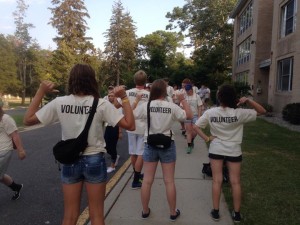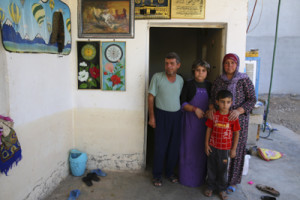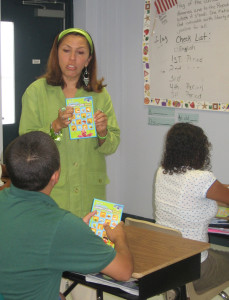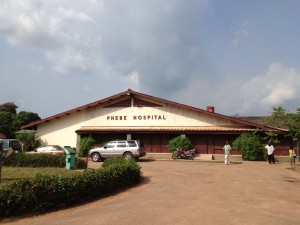
(Pictured: Nebraska Synod youth sporting Lutheran Disaster Response volunteer shirts as they embark on their volunteer projects.)
This July, more than 300 youth and chaperone volunteers from the ELCA Nebraska Synod ventured on a cross-country bus trip to New Jersey. As part of the synod’s annual youth mission trip, the group spent a week in New Jersey to participate in on-going disaster recovery work from Superstorm Sandy.
“The synod takes a trip every year, with every third year to the national youth gathering,” said Kari Fry of St. Timothy’s Lutheran Church, who helped plan the trip. “In the recent past, the focus of the trips has been on mostly urban ministries. The synod hasn’t gone to a place of natural disaster since [Hurricane] Katrina, and we felt that this was an important experience for the youth to have.”
Superstorm Sandy struck the Jersey Shore in October 2012, and recovery work has been on-going ever since. Lutheran Disaster Response has been working with Lutheran Social Ministries of New Jersey (LSMNJ) to assist in the long-term response. While Superstorm Sandy is no longer receiving national media attention, the destruction and devastation caused by the storm is still very prevalent in the communities that were impacted.
Door-to-door recovery
Amy Pennenga, disaster recovery coordinator for LSMNJ, has been driving the Superstorm Sandy recovery projects and was very excited to receive this large group of volunteers.
“This is definitely the largest group of volunteers I’ve worked with,” Pennenga said. “We started planning the trip a year in advance, which allowed me enough time to find communities where they could work and have housing during their stay.”
Working with a group this large allowed Pennenga to get creative and plan projects that she usually doesn’t have enough volunteers to cover.
“Some of the volunteers participated in rebuilding homes, cleaning up a camp and working in a food pantry,” Pennenga said. “The majority of the group, 250 of them, worked on a canvassing project, handing out flyers for the long-term recovery group in the community and asking people what they needed. They gathered information, such as how many homes have been elevated and how many homes still need repair. This canvassing is something we’ve wanted to do for a long time, but we never had enough people. This group made it possible.”
“New Jersey is Still Recovering”
On the group’s last evening in New Jersey, they all donned red shirts and converged on the boardwalk with a large banner that said, “We Are With You – New Jersey is Still Recovering.” Gathered all together on the boardwalk, the group sang “Lean on Me” while people from the community watched and were filled with emotion.
“We saw one older lady crying,” Pennenga said. “Her home had been destroyed by [Superstorm] Sandy and she was still struggling with the rebuilding process and she felt like everyone had forgotten. She said it was so encouraging to see this group of people from several states away acknowledge the work that still needs to be done.”
Fry also expressed the community’s reaction.
“Everyone was so gracious and grateful,” Fry said. “Our goal was to draw attention to the reality that recovery is still on-going. Whether someone is a New Jersey resident, neighbor or from states far away, people need to know that their help is still needed and will be needed for years to come.”
Lutheran Social Ministries of New Jersey accepts volunteers year-round and while the focus of work is on home rebuilding, volunteers do not need to be skilled.
“We are very much in need of volunteers,” Pennenga said. “We conservatively still have one thousand homes left to rebuild after already doing 500. It is overwhelming for the people here. There were so many people impacted and it’s easy for people to get lost in the cracks. We fight every day to make sure that the most vulnerable don’t get forgotten in the crowd.”
If you are interested in volunteering in New Jersey, please contact Amy Pennenga of Lutheran Social Ministries of New Jersey at apennenga@lsmnj.org or 609.699.4137.





